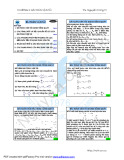
Subgradient Method
Hoàng Nam Dũng
Khoa Toán - Cơ - Tin học, Đại học Khoa học Tự nhiên, Đại học Quốc gia Hà Nội

Last last time: gradient descent
Consider the problem
min
xf(x)
for fconvex and differentiable, dom(f) = Rn.
Gradient descent: choose initial x(0)∈Rn, repeat:
x(k)=x(k−1)−tk· ∇f(x(k−1)),k=1,2,3, . . .
Step sizes tkchosen to be fixed and small, or by backtracking line
search.
If ∇fLipschitz, gradient descent has convergence rate O(1/ε).
Downsides:
◮Requires fdifferentiable — addressed this lecture.
◮Can be slow to converge — addressed next lecture.
1

Subgradient method
Now consider fconvex, having dom(f) = Rn, but not necessarily
differentiable.
Subgradient method: like gradient descent, but replacing gradients
with subgradients, i.e., initialize x(0), repeat:
x(k)=x(k−1)−tk·g(k−1),k=1,2,3, . . .
where g(k−1)∈∂f(x(k−1))any subgradient of fat x(k−1).
2

Subgradient method
Now consider fconvex, having dom(f) = Rn, but not necessarily
differentiable.
Subgradient method: like gradient descent, but replacing gradients
with subgradients, i.e., initialize x(0), repeat:
x(k)=x(k−1)−tk·g(k−1),k=1,2,3, . . .
where g(k−1)∈∂f(x(k−1))any subgradient of fat x(k−1).
Subgradient method is not necessarily a descent method, so we
keep track of best iterate x(k)
best among x(0), ...x(k)so far, i.e.,
f(x(k)
best) = min
i=0,...,kf(x(i)).
2

Outline
Today:
◮How to choose step sizes
◮Convergence analysis
◮Intersection of sets
◮Projected subgradient method
3

![Đề cương bài giảng Các phép toán tối ưu [mới nhất]](https://cdn.tailieu.vn/images/document/thumbnail/2021/20210303/gaocaolon10/135x160/3121614754463.jpg)























![Quyển ghi Xác suất và Thống kê [chuẩn nhất]](https://cdn.tailieu.vn/images/document/thumbnail/2025/20251030/anh26012006/135x160/68811762164229.jpg)
